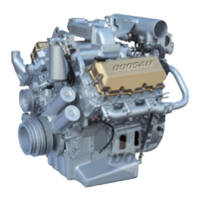DV11
Operation and Maintenance
143
Common Rail Fuel-injection System
Printed in Mar. 2005 PS-MMA0608-E1A
3.6.2. Theory of operation
z Energizing the engine brake effectively converts a power producing diesel engine
into a power absorbing air compressor. This is accomplished by opening the
cylinder’s exhaust valve (A) near the top of the normal compression stroke,
releasing the compressed cylinder charge back into the atmosphere.
z The blow-down of the compressed cylinder charge to atmosphere prevents return
of the stored energy to the piston on the expansion stroke. The effect is a net
energy loss, since the work done in compressing the cylinder charge is not
returned to the crankshaft during the expansion stroke. The energy being lost is
slow the vehicle on level roads and help control vehicle speeds on downhill
grades.
z The power required to operate the brake is obtained from the engine’s camshaft
and rocker arms (B). The motion of the exhaust rocker arm is utilized to open the
exhaust valve and blow-down the cylinder.
z Energizing the solenoid valve (C) permits engine lube oil to flow under pressure
(D, E) through the control valve to both the master piston (G) and slave piston (H).
z Oil pressure causes the master piston (G) to move down, coming to rest on the
corresponding exhaust rocker arm (B).
Slave piston
(H)
Adjusting screw
(L)
Oil inlet
(D)
Solenoid valve
(C)
Control valve
(F)
Check valve
(K)
Low
pressure oil
(E)
High pressure oil
(J)
Exhaust rocker arm
(B)
Master piston
(G)
Exhaust valve
(A)

